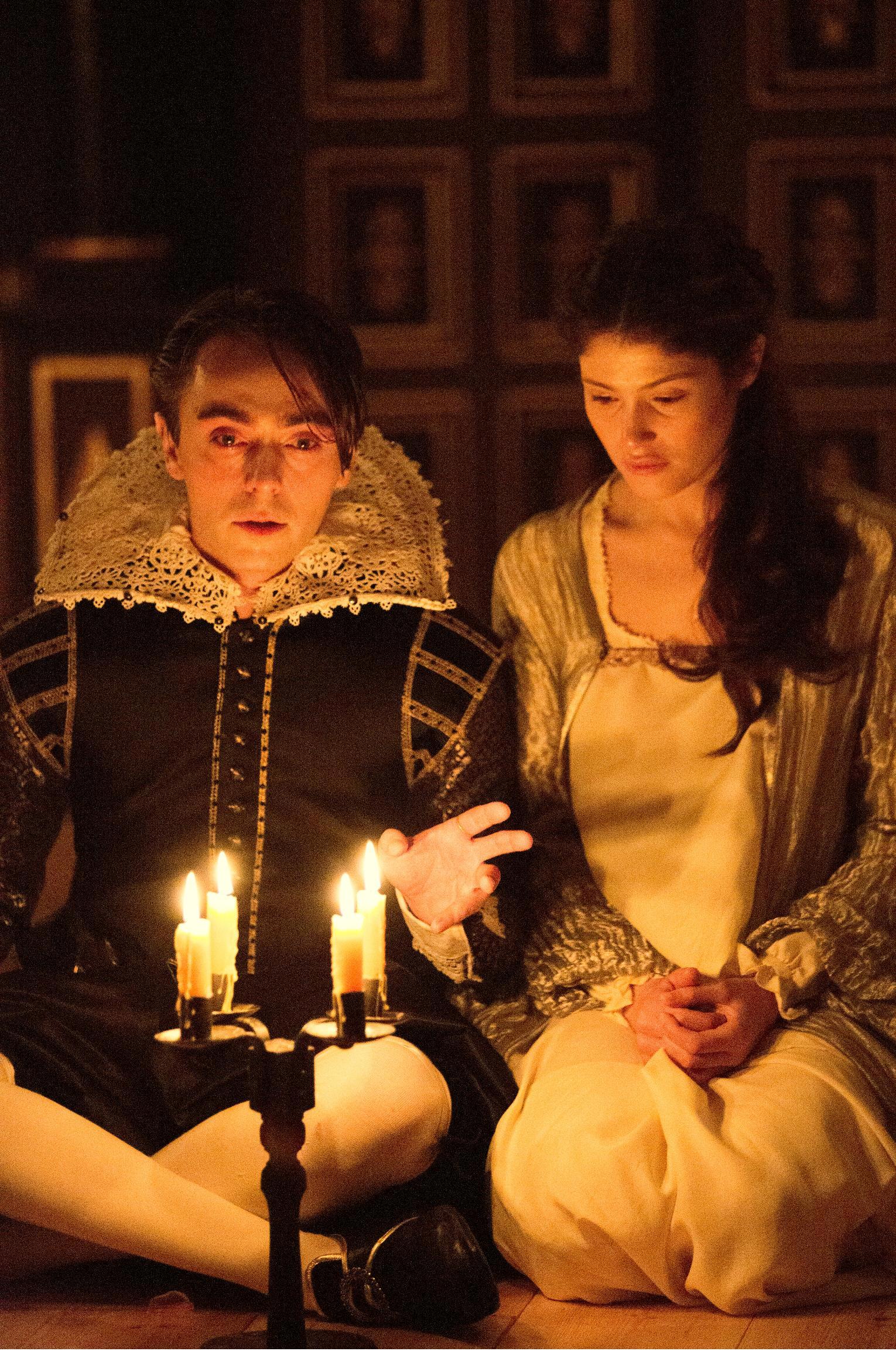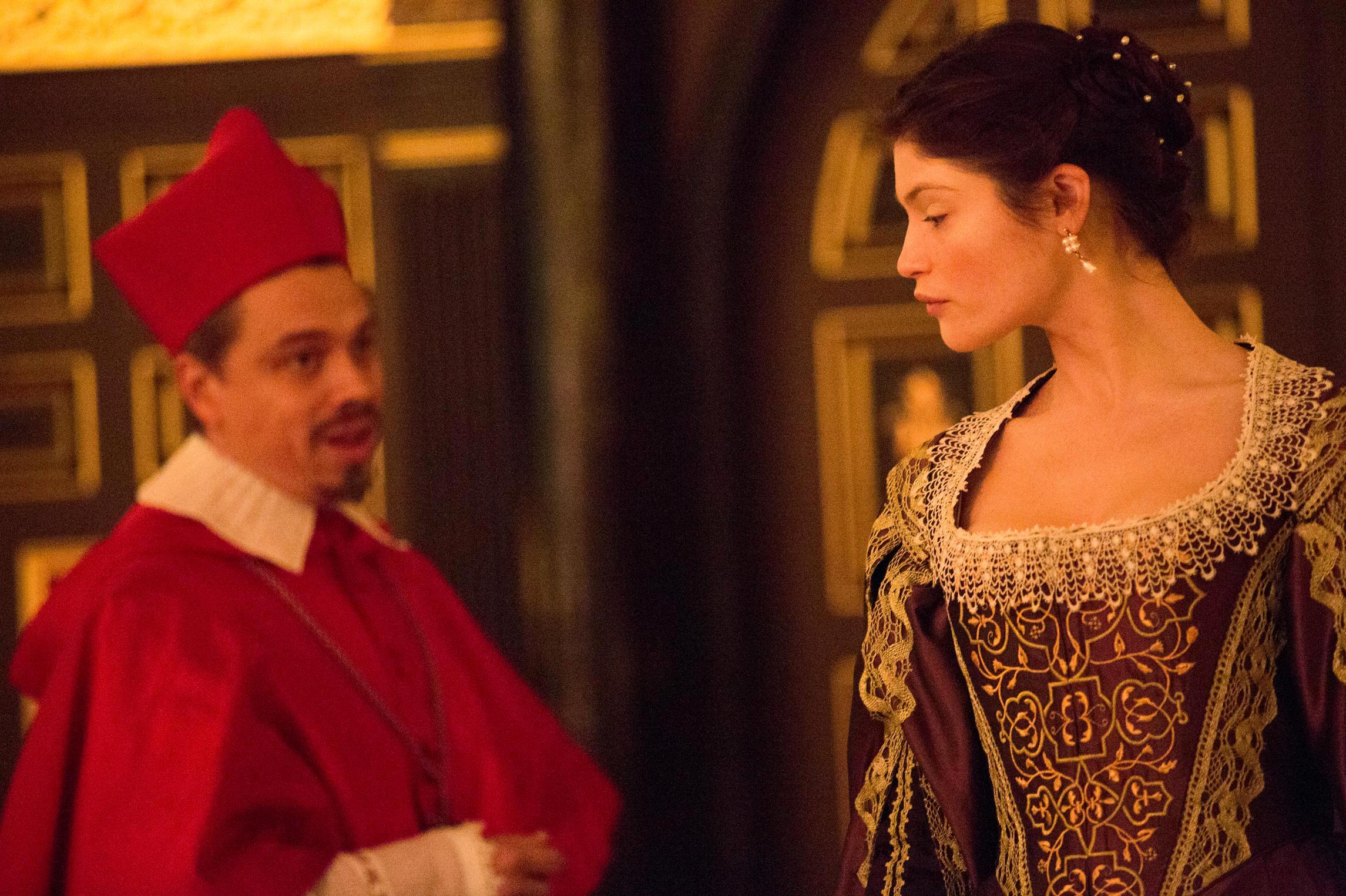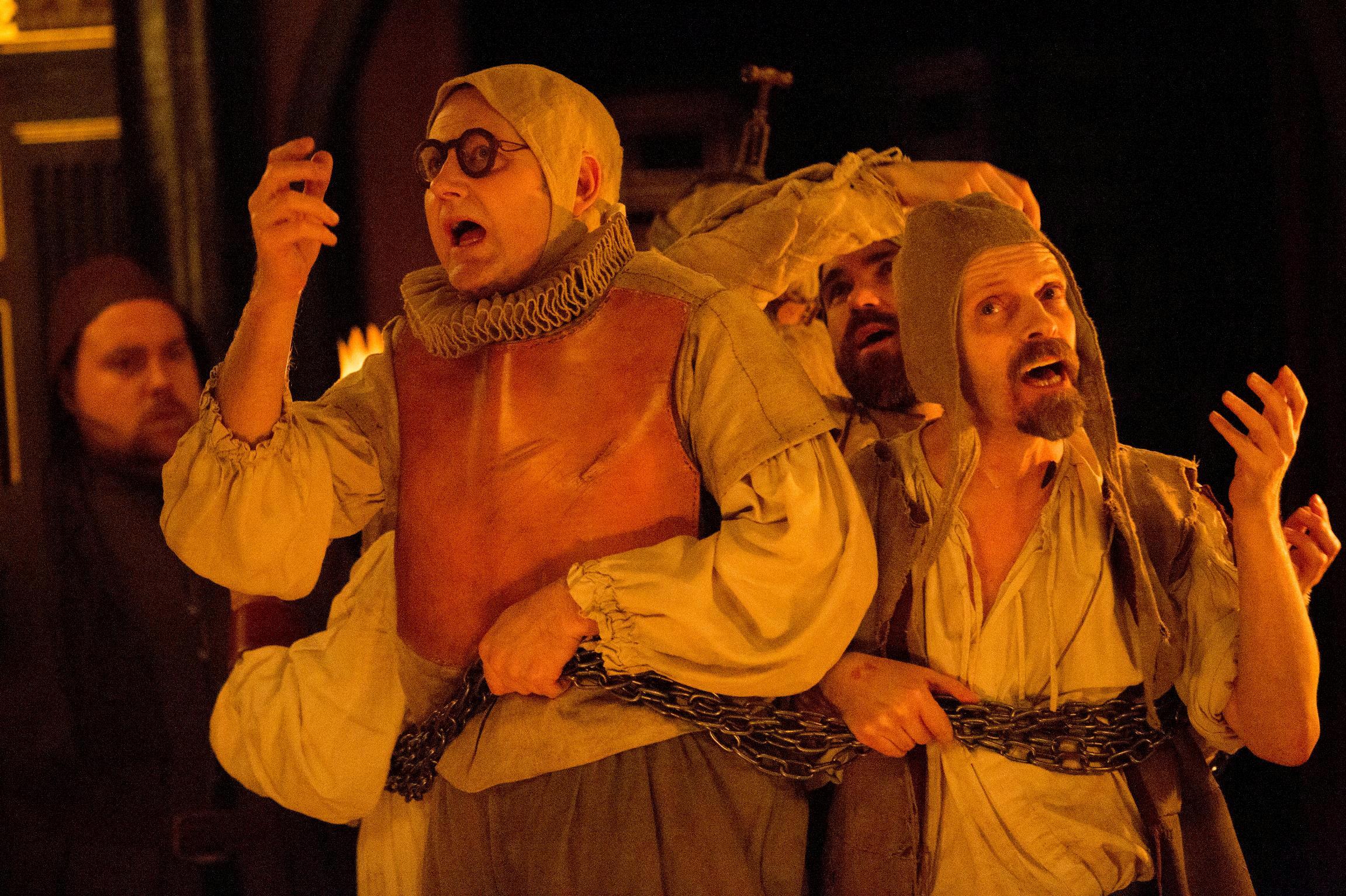- Accueil
- > L’Oeil du Spectateur
- > N°6 — Saison 2013-2014
- > Autour de Shakespeare
- > The Duchess of Malfi, John Webster, directed by Dominic Dromgoole, playing at the Sam Wanamaker Playhouse, from 9 January-16 February 2014.
The Duchess of Malfi, John Webster, directed by Dominic Dromgoole, playing at the Sam Wanamaker Playhouse, from 9 January-16 February 2014.
Par Stéphanie Mercier
Publication en ligne le 26 février 2014
Résumé
Dominic Dromgoole’s curtain raising production of The Duchess of Malfi for the première season in the Globe’s new indoor playhouse is also a fitting first venue for the intimate and haunting circa 1613 play, which was probably initially performed privately at Blackfriars. The transformation inherent to staging a four-century old plot in a cutting edge resurrected theatre, that has nonetheless been rebuilt so that Webster himself might have recognised it, is thus one that highlights the continuing restless energy of the playwright’s pen. Furthermore, Gemma Arterton’s memorable performance of the un-named Duchess is a fitting evocation of both Webster’s own largely unchartered life and the lingering legacy of his literary works – in this instance a plot performed in period costume, including ruffs and rapiers, and to the original score sheet for authentic acoustic surround – at once a haunting remembrance and an imaginative reshaping of the play.
Texte intégral
Introduction
1Sitting, as I was, in the Balcony, in Upper Gallery along with the musicians, and sometimes with the actors themselves, gives a unique perspective upon the action, which is here framed in a tiny space and enclosed by a 360° group of spectators whose reactions are, at times, the only clue to thespian facial expression heading frontwards. This notion of circumference is echoed in the eight circle-shaped candle-lit chandeliers, which beam upon the stage and are progressively raised or lowered at different points in the action to give intensity, synchronization and strength on the otherwise barely propped theatre planks. The visual effects are audibly accompanied by the rounded sound of the cello, the three different types of lute and the harpsichord, which requires regular re-tuning as if to underline the necessary reunion of the otherwise disrespectful handling of traditional neo-classical unities of time and space, or bodily and spiritual orthodoxy, throughout Webster’s plot.
Sharing space
2The play’s script immediately points to this multifaceted doubling as the widowed Duchess, her twin brother Ferdinand (David Dawson) and the older sibling Cardinal (James Garnon) metaphorically become « three fair medals, / Cast in one figure, of so different temper » (I.1.179-180)1. The comparison, apart from underlining the different personalities of the characters, establishes a diptych of corporality and materiality that will underscore the action and hint to how the Duchess’ passionate marriage with her adoring, yet socially inferior, steward will inevitably encourage disaster. With similar numismatic imagery, the Cardinal offers Bosola (Sean Gilder) gold coins to become a spy (and murderer) at the Duchess’ court whilst the actors eat symbolically charged strawberries off circle-shaped pewter platters in a hint to the curvaceous nature of the Duchess’ soon-to-be rounded pregnant belly. In fact, the tragic nature of what should be happy events to come is also pointed to by the premonitory dagger on stage; an appropriate metaphor for the particular « variety of courtship » (I.1.329) that characterises the play and that is immediately transferred to the quill that the steward, Antonio (Alex Waldmann), uses to write what turns out to be the Duchess’ gloomily foreboding will. This, before she presumptuously oversteps moral, legal and social boundaries (here signified by the fact that the two are initially separated by the flaming lowered candles while they court) and gives him her wedding ring as a token of betrothal – yet another circle, and, more importantly, a pointer to the rope that will finally encircle her neck.

The Duchess (Gemma Arterton). Photograph by Mark Douet
3In a play consistently concerned with the discrepancy between masculine and feminine power, it is the serving maid, Cariola (Sarah MacRae), who marries the Duchess and Antonio in an informal ceremony2, where she stands above the kneeling pair in a visually striking inverted social pyramid at the end of Act One.

Cariola (Sarah MacRae). Photograph by Mark Douet
4Nine months have already passed by the next Act where the Duchess’ defiantly hurried full-term pregnancy efficiently highlights her reckless swing full circle with regards both to her brothers’ resolve that she should not remarry and the wider refusal of allegiance to ecclesiastical principle. Antonio similarly becomes puffed up, not with the preferment, which convention would deny him, but, like the Duchess, because of the « apricocks3 », which spectators see her « greedily » (II.1.140) devouring, and which are the « forced occasion » (II.1.159) made use of to disguise her confinement that could otherwise cause her husband’s captivity.
5If dangers are temporarily averted, the artificiality of the concealed conception is a forerunner to future betrayal. This is now made clear as spectators witness Antonio’s handkerchiefed initials ominously drowned in his own blood, before he fatally leaves his unconventionally conceived son’s nativity chart on stage for Bosola to find and take to the corrupt Cardinal’s court. There, Ferdinand, in a striking mirror image of Antonio’s earlier action, takes his own handkerchief and transforms it into a potential weapon with which to strangle his twin sister.

The Cardinal (James Garnon) and Ferdinand (David Dawson). Photograph by Mark Douet
6His agitation is highlighted as he refuses to sit still despite the Cardinal’s bemused, then enraged, entreaties and then he feverishly insists upon knowing who « leaps » (II.5.80) the Duchess – whom he sees as no longer belonging to him but to an imagined rival. Then, in another theatrical bound and in alarming arrogance, he claims that « He that can compass me […] May say he hath put a girdle ‘bout the world » (III.1.84-85)4 – a statement that exemplifies the confusion of the circle of power and authority, along with personal and public misrule, at work in the action all through.
Domestic decay
7Ferdinand’s increasingly disordered mind will logically next push him to penetrate the domestic sanctuary of the Duchess’ bedchamber with a metaphorically connoted dagger and, in Dromgoole’s production, physically attempt to ravish his own sister. Just previously, and in what René Weis terms as « a unique view of the private and domestic lives of the Duchess and Antonio5 », we see the tenderness and intimacy of « the Duchess getting ready for bed and combing out her hair in front of a mirror6 ».

The Duchess (Gemma Arterton) and Antonio (Alex Waldmann). Photograph by Mark Douet
8Alternatively, the self-gazing and subsequent violation is something that Keith Sturgess regards as « a Renaissance emblem of shattering power […] the vain woman, her vanity symbolised by the mirror, visited by Death as a retribution for a moral laxity of which the play never acquits her7 ». The ambiguity was kept intact here with an initial tableau of Cariola placing coals into a warming pan and Antonio seated on the stage listening to the Duchess at her candle lit dressing table to underline the interior nature of her musings: « Doth not the colour of my hair ‘gin to change? » (III.2.58), followed by a devastating exteriorised repetition of events as the Duchess is seized by her brother around the neck in mock strangulation and then the two sit front stage in candlelight – before the Duchess seizes the outstretched poniard herself to encompass a greater worldview and declare: « For know, whether I am doomed to live or die, / I can do both like a prince. » (III.2.70-71).

Ferdinand (David Dawson) and the Duchess (Gemma Arterton), Photograph by Mark Douet
9Despite the promise of renewed life force that her former and future pregnancies should offer, the dangerous autonomy signified by an independent woman’s coming of age in an essentially patriarchal society condemns the Duchess to ever-decaying domesticity. Ferdinand’s dagger, just as Antonio’s will-writing quill earlier in the action, signifies a severance that can no longer be compensated for within a framework of solipsistic invention and this is shown in the couple’s forced separation. The duchess’ initial insubordination thus forces further invention – the narrative of Antonio’s financial extortion as a crime seemingly worse than his sharing her bed – in an attempt to flee her court for a « feignèd pilgrimage » (III.2.320). However, this duality will ultimately undo the Duchess because she naively commits the fatal act of confessing the truth of her marriage and three children to the falsely faithful Bosola. And, after the audience hears her verbally forfeiting her life, she is subsequently seen constrained to physically leave the stage, as her ever-constricting fictional circle of truth jails her, not only in an illusory battle with her brothers, but in a « jesting with religion » (II.2.319).

The Cardinal (James Garnon) and the Duchess (Gemma Arterton). Photograph by Mark Douet
10Accordingly, just before the interlude at the end of Act 3, the actors engage in an elaborate figure of eight procession accompanied by religious chants to symbolise the dramatic artificiality of the Duchess’ vows. She is next seen approaching the stage, with Antonio and her now three children, from the public aisle whilst the dumb show of the Cardinal’s [instalment in the habit of a soldier] (III.5), occurs above. The Duchess’ mock expiation culminates in her predictably tragic simultaneous church and state rejection as she is banished from Ancona by her own brother and then imprisoned by her erstwhile confident Bosola, who walls her up in a misery of silence in the condescendingly hypocritical name of « safety and pity » (III.5.109).
Defiant self-destruction
11The audible quietening is further paralleled in the shadows that engulf the stage at the Duchess’ entreaty (IV.1.30). The smell of snuffed candles and wax invades the theatre and the misery that is next wrought upon the Duchess is that of the horrifying unseen Ferdinand, whose heavy breathing is ever evocative of his previous perversity, and who torments her with further jealous talk of desecration. He leaves her alone, with a [dead man’s hand] (IV.1) and, as the candles are relit, the audience, along with the now distracted Duchess, see that Ferdinand’s forsaken love token is in fact what seems to be Antonio’s discarded severed ringed forearm. She is further tormented with another dumb show of what appears to be Antonio and her children [appearing as if they were dead] (IV.1) and then, as fits a character who admits that now « nothing but noise and folly / Can keep me in my right wits » (IV.2.5-6), she is subsequently aggressed, this time audibly, by a group of madmen who are brought chained on stage only to be released among the audience.

The Mad Astrologer (Dickon Tyrell) and the Mad Lawyer (John Dougall). Photograph by Mark Douet
12There, they unsteadily walk along the gallery balustrades or sit next to patrons who have no choice but to good-humouredly listen to their as equally as unbalanced ranting. The group then jigs to the original harpsichord score sheet, something that points to madness as continuing spectacle, before stretching their arms out to the Duchess as if in invitation to the lunacy of loss that is to follow. As the black figure of Bosola disguised as Death appears to execute an unworthy « Peace » (IV.2.163), jarringly connoted by the ringing of the stage bell, Cariola in similar oxymoronic sonority and looking back stage to stare at Death head-on, becomes increasingly hysterical whilst the ever-calm Duchess merely gives out advice that her boy should be given syrup and her girls say prayers (IV.2.196-197). Both, along with the Duchess’ infants, are then strangled in the tragic climax of the action – the mother’s final choking gasps of life being followed by a demise denoting silence whilst the audience, as equally as silently and with a proximity that appears for some quite unnerving, watch on.
13Ferdinand’s ensuing guilt-induced lycanthropy, the outward expression of his inner chaos, is reflected by Antonio’s own lunacy in the hope of « reconciliement / To the Aragonian brethren » (V.I.1-2). Moreover, Ferdinand whines like a puppy before irreverently biting his hapless Doctor (John Dougall), in what is now a highly symbolically charged forearm, with a triumphant « like beasts for sacrifice; there’s nothing left of you, but tongue and belly flattery and lechery » (V.2.78-79) that exemplifies his descent into further diabolical dehumanisation. Indeed, his own caustic mistress, Julia (Denise Gough), whose unabashed immorality often provides some very welcome comic relief to the action, next very plausibly laughs at the equally as brutish Cardinal when he confesses to his sister’s murder – this before he next irreverently kills her himself by means of a poisoned kiss on the Bible (V.2). Then, after Julia’s body is taken offstage to analogous music that has previously accompanied the other corpses hence, Antonio’s words are similarly echoed from the grave by the Duchess, who finally appears, ghost-like in the Balcony, to voice the prophetic « Never see her more » (V.3.42).
Conclusion
14To highlight the transformative power of play acting that is at work up to the end of the action, the Cardinal imparts his intention to feign madness so that he may convey Julia to her final lodgings while Ferdinand appears whirling around the stage, taking a spectator’s hand and enquiring whether his startled newly-improvised attendant consents that « Strangling is a very quiet death […] do you not agree? » (V.4.33-35). Indeed, after Antonio is mistakenly murdered by Bosola – in what is perhaps an ultimate moment of consciousness of how even an actor cannot extract himself from the compromises of the world – he looks upwards to the theatre’s zodiac painted ceiling and laments that « We are merely the stars’ tennis balls, struck and bandied » (V.4.53). Furthermore, in a statement about how life so frequently appears as some perverted pastime, the actors who next appear in the Balcony to observe what they believe to be the Cardinal’s previously announced feigned madness simply retire to bed as if weary of the amusement. In this misused game of life, the former clergyman is then mistaken by his own brother for the Devil (V.5.52), before, in the scuffle that kills them both, seeming almost to have been slain by himself. Likewise, as Bosola also dies, his life ending « in a little point, a kind of nothing » (V.5.76) death seems little more than « a mistake as […] often seen in a play » (V.5.94-95). The action thus aptly ends as it would have done four-hundred years hence, with a haunting and elaborate jig – after the actors seemingly rise from death and face each other, and then all sides of the audience, in a renewed connectedness with past, present and, perhaps more importantly, with the playhouse of mortality.
Notes
1 John Webster, The Duchess of Malfi, Oxford, Oxford University Press, 2006, p. 114. All quotes are from this edition. Note that medals were traditional iconic methods of memorial of individuals and events as well as depictions of power and authority on both a personal and a political level.
2 « Secret marriages of this nature, while legally binding, still needed the sanction of the church before they could be consummated », in ibid., Introduction by René Weis, p. xx.
3 Borsola brings the Duchess « apricots » (II.1.124) but the term was efficiently perverted here to convey the raucously bawdy imagery that befits the comic qui pro quo of the action at this point in the play.
4 The medal imagery recurs here: « Francis Drake circumnavigated the globe between 1577 and 1580, and a medal of 1598 recorded his discoveries, each side showing a hemisphere with the voyage picked out across successive oceans […] encompassing the world was now a topical subject », Barrie Cook, Angels and Ducats: Shakespeare’s Money & Medals, London, British Museum Press, 2012, p. 19.
5 Ibid., Introduction, p. xxi.
6 Id.
7 Keith Sturgess, Jacobean Private Theatre, London and New York, Routledge and Kegan Paul, 1987, p. 114.